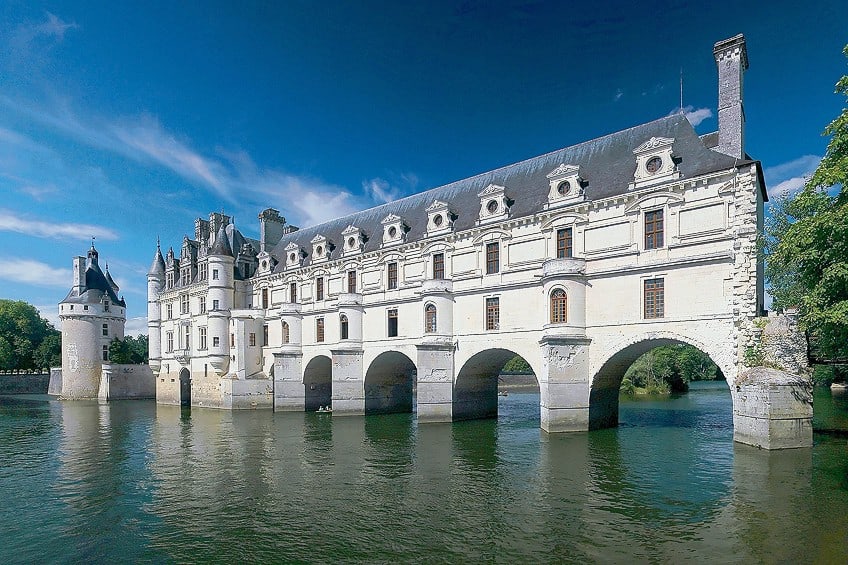Famous Castles – 15 Legendary Fortresses Worldwide
Whether you are a fan of fantasy games or are an avid history buff, castles have a way of capturing the imagination of pretty much everyone. After all, it’s not every day that we get to see the dwellings of ancient kings and queens outside of storybooks and television shows. That being said, there are many castles located all over the world that are open to the public, some of which have been meticulously maintained, and others that have weathered over time. These castles are often the pride and joy of the regions they are found in, and make headlines internationally at times. If you’re planning on visiting some of these castles, we’ve put together a list of famous castles, where to find them, what makes them famous when they were built, and their claim to fame!
Contents
- 1 Famous Castles Around the World
- 1.1 The Qaitbay Fort (882 CE)
- 1.2 Windsor Castle (1070)
- 1.3 The Bojnice Castle (12th century)
- 1.4 Castel del Monte (1240)
- 1.5 The Matsumoto Castle (1504)
- 1.6 The Château de Chenonceau (1513)
- 1.7 The Château de Chambord (1519)
- 1.8 The Fasil Ghebbi (17th Century)
- 1.9 Frederiksborg Castle (1620)
- 1.10 The Chapultepec Castle (1788)
- 1.11 The Nakhal Fort (1834)
- 1.12 The Red Fort (1834)
- 1.13 The Pena National Palace (1854)
- 1.14 The Neuschwanstein Castle (1868)
- 1.15 The Peleș Castle (1873)
- 2 Frequently Asked Questions
Famous Castles Around the World
Most famous castles around the world started out life as fortified positions from which their occupiers could defend their land, launch an attack, or fall back in the event of an invasion. Since we live in a more diplomatic era, these castles have been renovated to serve as lavish homes or historical artifacts.
Castles come in different shapes, sizes, configurations, and styles, so let’s have a look at some of the most popular old castles around the world.
The Qaitbay Fort (882 CE)
| Date Created | 882 CE |
| Type of Architecture | Ancient Egyptian fort |
| Location | Alexandria, Egypt |
| Type of Castle | Stone fort |
Many (if not all) of the castle’s old castles now in existence were born out of the need to defend a particular location and/or region. The Qaitbay Fort is no exception to this rule as it was built by one Sultan Al-Ashraf Qaitbay as a response to the ever-encroaching presence of the Ottoman empire in the region of Alexandria. The fort began construction in 1477 as a response to this impending threat.
Since the fort needed to be constructed quickly and be highly defensible, the builders decided to use the existing foundation of the Pharos Lighthouse as a base.
Pieces from the aforementioned lighthouse were used in the construction of the fort, namely the red granite pillars which were integrated into the design of the fort. As we now know the Ottoman empire would eventually capture and occupy Egypt. The fort would remain intact even after the famous British bombardment that took place in 1882. The castle would remain neglected in the 1900s until a restoration effort was undertaken by the Egyptian supreme council of antiquities. These days the castle functions as a maritime museum that is open to the public.
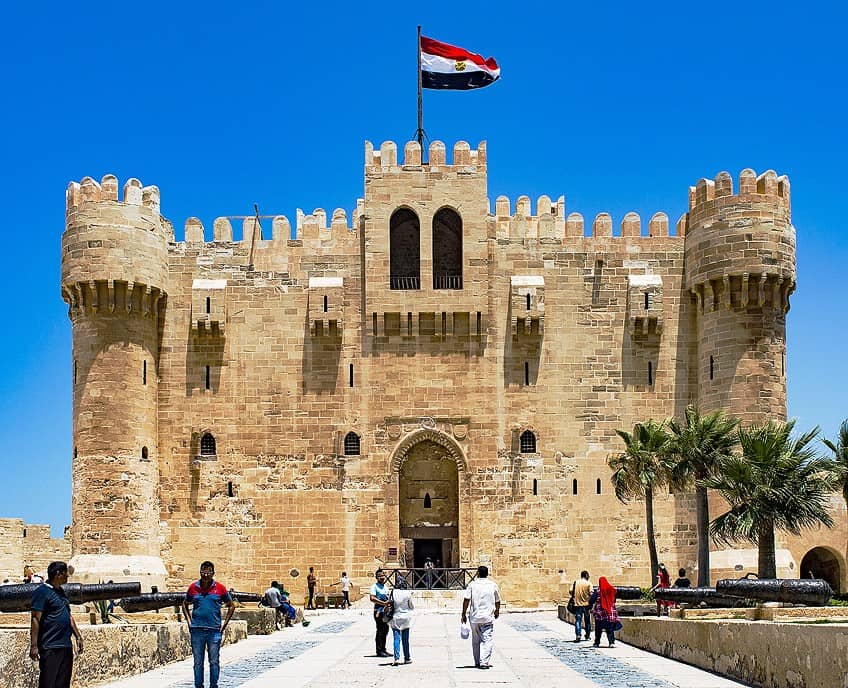
Windsor Castle (1070)
| Date Created | 1070 |
| Type of Architecture | Gothic, Georgian, Victorian |
| Location | Windsor, United Kingdom |
| Type of Castle | Gothic palace |
Even if you aren’t a history buff, if someone asked you to name a castle, this one is probably what comes to mind. As the longest inhabited castle in the world, Windsor castle has been the primary residence of the British Royal Family for 1000 years.
The castle has been restored and maintained countless times, and has hosted world leaders, entertainers, and athletes for virtually as long as it has existed!
Monarchs that have called the castle home have made numerous renovations over the years, including the chapel added by Queen Victoria that burned down in 1992, taking nearly 100 rooms along with it. As we know, the damage to the fire was repaired and the castle was restored to the state we know and love today.
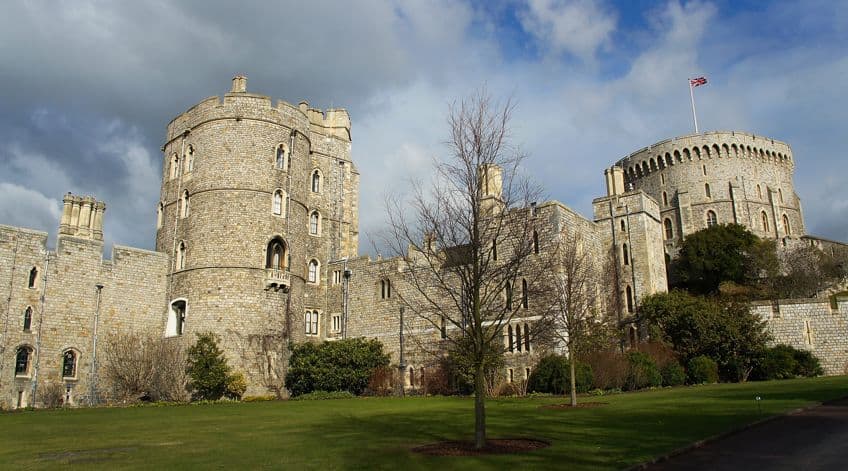
The palace has been the location of many, many weddings, and social gatherings over the years. It is also known to have been a place of relaxation and reflection for both the Queen and Prince during her reign. In 2021, when Prince Philip passed away, the Queen is said to have spent more and more time here.
The Bojnice Castle (12th century)
| Date Created | 12th century |
| Type of Architecture | Gothic Revival |
| Location | Bojnice, Slovakia |
| Type of Castle | Stone fort |
If you’re interested in unique European castles, we highly recommend that you check out the Bojnice in Slovakia. This castle is recorded as starting out as a simple Motte and Bailey fort, but like many castles around the world, it would eventually be developed into a stonework fort.
Records indicate that the castle was built around 1113 CE and as soon as the 1500s it resembled the castle we know today.
King Matthias Corvinus is famously associated with the castle grounds as he was known to practice his many decrees in a tree on the castle grounds, one which holds his name today! The castle would change hands many times as the years went on, and each owner sought to add their own personal touch to the structure while maintaining the overall look and feel of the architecture.
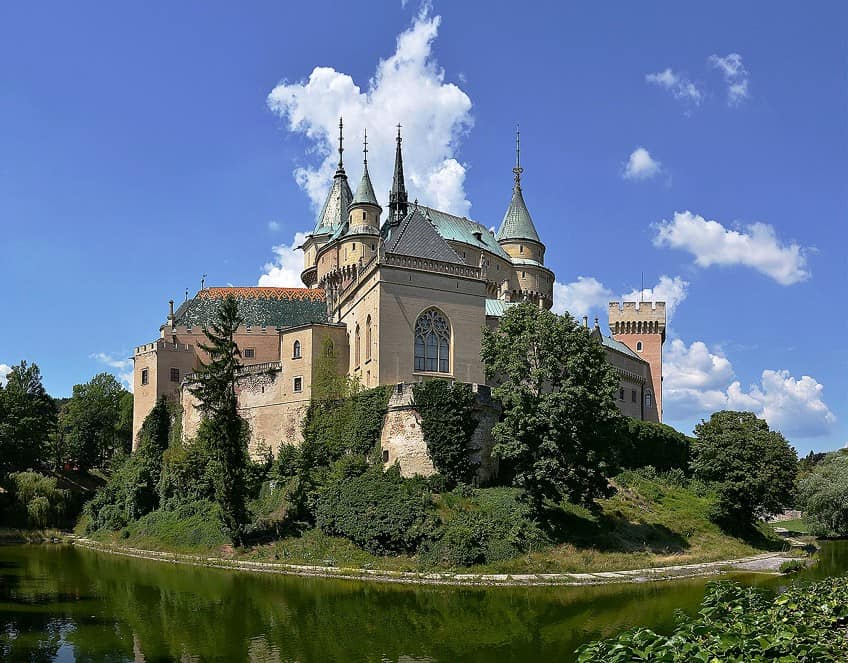
Count Ján Pálfi is the one who would eventually maintain the most notable owners of this castle. Infatuated with its fairy-tale appearance and gothic lines that stretched up toward the heavens, he made the home of his many priceless antiquities and artworks. The castle in combination with the stunning scenery surrounding it has made it one of the most frequently visited castles in Europe.
Castel del Monte (1240)
| Date Created | 1240 |
| Type of Architecture | Gothic, Romanesque, Norman |
| Location | Andria BT, Italy |
| Type of Castle | Stone fort |
While France has beautiful castles scattered all over its landscape, Italy also has some incredible castles you can check out should you find yourself in the region. This castle was commissioned for construction by Frederick II in 1240 by Frederick II, the Roman emperor at the time. The castle was constructed in quite a remote and subsequently exposed location in the countryside.
The strange thing about the castle is that once construction had been completed and the structure had been decorated to the King’s taste, it was almost immediately abandoned.
This left many people scratching their heads regarding the purpose of the castle’s construction and indeed what would happen to the castle now that it was abandoned. Architects and scholars that have studied the structure have been amazed by both its design and beauty. The castle is built on an octagon-shaped base, while each of the eight corners had a tower placed on it. The tower consists of two stories, and each floor has eight trapezoid-shaped rooms inside of them, making the interior just as unique as the exterior.
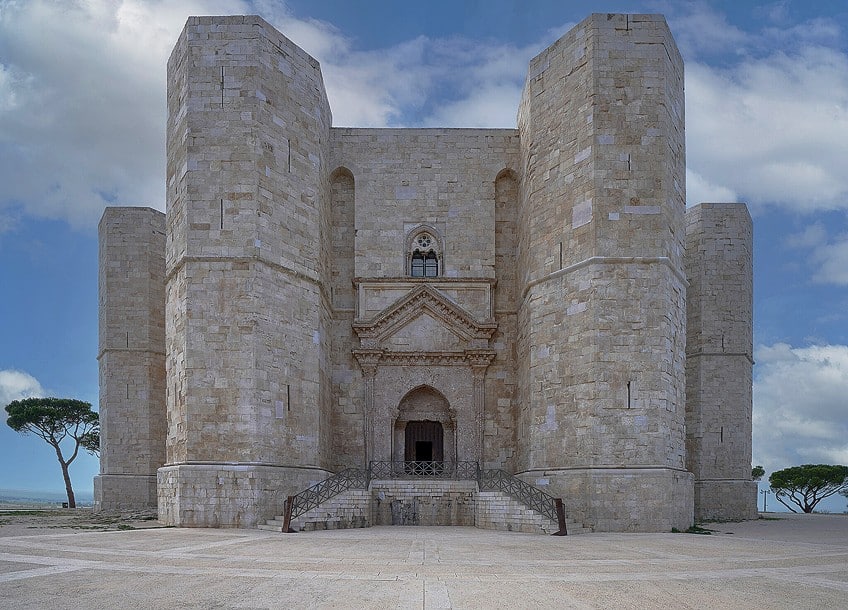
While the purpose of the geometry implemented in the design of the castle is unknown (and has been speculated upon a lot over the years) it is widely accepted that it was meant to evoke the relationship between God and man, as well as the Holy Grail. This castle receives loads of visitors every year and has been dubbed a UNESCO world heritage site as a result.
The Matsumoto Castle (1504)
| Date Created | 1504 |
| Type of Architecture | Boro and Soro architecture |
| Location | Matsumoto, Nagano Prefecture, Japan |
| Type of Castle | Ancient Japanese fort |
One of the most historic castles worldwide is the Matsumoto castle in Japan. Its unique Japanese architecture sets it apart from some of the other historical castles on this list, but don’t be fooled by its elegance. The Ogasawara clan built the castle initially as a fort, but they would not get to enjoy its protection for very long.
The stunning castle would be captured by the warlord Takeda Shingen only a few years later.
He wouldn’t hold onto it for too long either, as like many historical castles, it would switch hands a few times throughout its history. The Matsumoto Castle is known for its elegant appearance, sweeping lines, black walls, and its nickname “crow castle”.
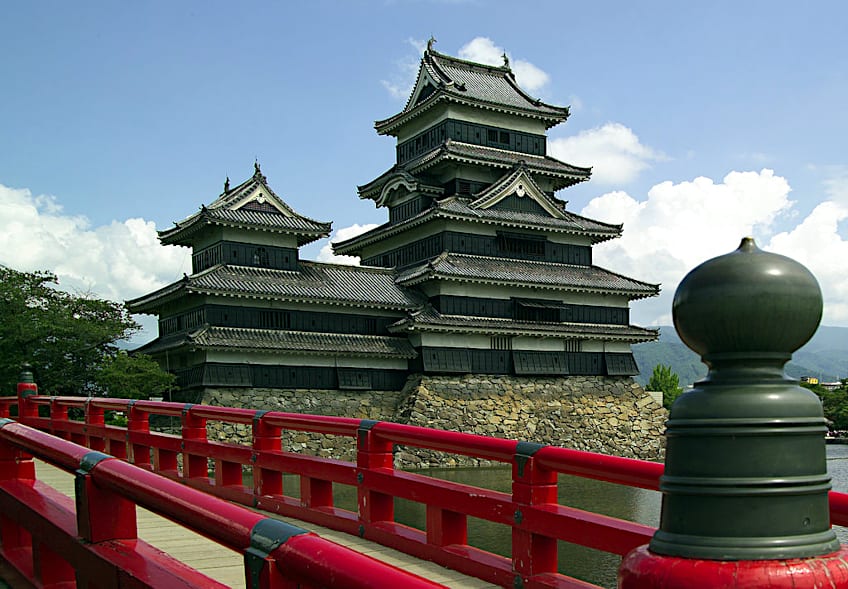
Space comes at a premium in populated areas of Japan, so it comes as no surprise that in 1872 the castle was scheduled for demolition in order to build more housing units. However, the people of Matsumoto advocated against this, and eventually, after much litigation, the city of Matsumoto acquired the castle under its purview. These days, the castle is officially recognized as a national treasure.
The Château de Chenonceau (1513)
| Date Created | 1513 |
| Type of Architecture | Renaissance/Gothic |
| Location | Chenonceaux, France |
| Type of Castle | Stone fort |
France is home to a number of ancient structures that date back to the times of Royalty and revolution for the people. Like many countries that participated in monarchs and similar leadership types, it is home to quite elegant castles like the Château de Chenonceau. The original design was executed by Philibert de L’Orme who was commissioned by the mistress of King Henry II (Diane de Poitiers).
This castle is exceptionally beautiful and appears to be floating on the crystal waters that surround it.
The long spires pointing toward the heavens and its light color palette evoke a fairytale-like appearance, so it comes as no surprise that Catherine de’ Medici made it her favorite abode upon the death of Henry II. There are few castles around the world that are comparable to their beauty. Its interior and exterior were well-used, as the castle was constantly the spot of lavish parties and ceremonies throughout the years. Catherine de’ Medici was known for her amazing hosting skills, and it’s even rumored that the first fireworks ever set off in France were lit from this very castle!
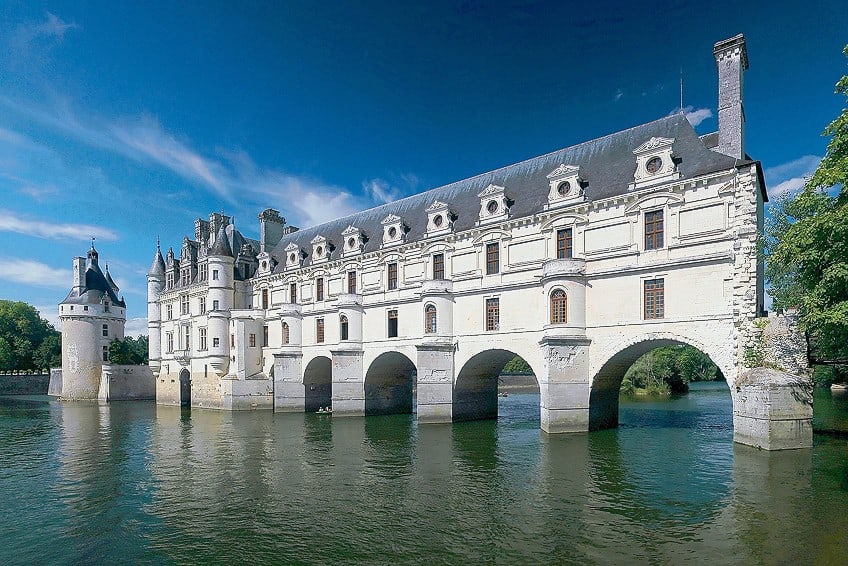
This was done to celebrate her son’s ascension to the throne, an occasion well-documented in world history. Another prominent point in history associated with the castle is the second world war, which saw the castle come under fire by German troops, nearly destroying it. Thankfully, after the war, the castle and the beautiful gardens surrounding it would be restored to their former glory by Bernard Voisin.
The Château de Chambord (1519)
| Date Created | 1519 |
| Type of Architecture | Renaissance/Classic/French |
| Location | Chambord, France |
| Type of Castle | Stone fort |
Some of the most famous castles in the world can be found in France, but none of them are quite like the Château de Chambord. This castle was initially built as a weekend getaway by King François I for hunting trips in 1519, and due to the King’s infatuation with the worlds of artist and engineer Leonardo da Vinci, the castle had a number of elements inspired by Italian Polymath.
The castle is designed to be a representation of classic Renaissance architecture.
The castle has a number of impressive features on its interior too including but not limited to a double helix staircase, 280 fireplaces, 400 rooms, and 80 staircases, all spread out over the estates sprawling interior. While you might think that the castle was well lived in considering so much effort was put into the construction and interior design, King François I only stayed here for about two weeks during his reign as king. According to the record, the King found the location to be too elaborate to spend a prolonged amount of time in.
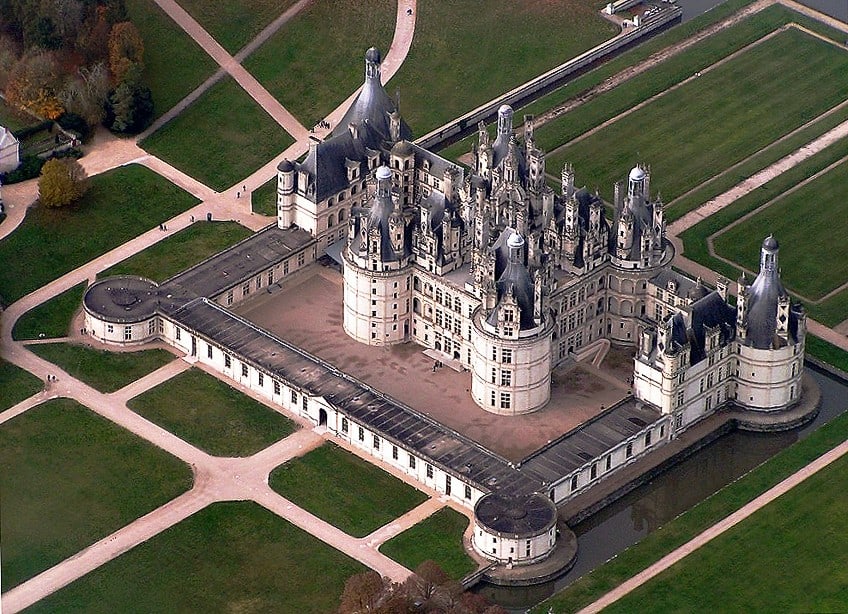
Therefore, the castle instead stood as a symbol of the power and wealth of the Monarchy. The castle is used far more often these days though, as it hosts a number of events throughout the year, including an event where the castle is beautifully decorated with thousands of lights! This display is magical and is well worth the trip.
The Fasil Ghebbi (17th Century)
| Date Created | 17th Century |
| Type of Architecture | Baroque style |
| Location | Gondar, Ethiopia |
| Type of Castle | Stone fort |
While in some parts of the world, castles are pretty commonplace, in others, they are rare, not non-existent. One of these regions is Ethiopia, in which rulers who were held in high regard would live nomadically, traveling from settlement to settlement and living off the offerings of the people while sleeping in a tent or similar structure.
The castle was built in 1636 by Emperor Fasilides.
This was a huge change from the traditions of previous leaders who had lived on the land, and it wouldn’t be the only change he implemented. Emperor Fasilides also founded the then-new capital city of Gondar, yet another first for the region of Ethiopia. While you might expect this to be a simple castle the structure is actually a castle complex that consists of gardens, temples, libraries, a pool, and (of course) living quarters for the royal family. The palace would continue to be extended, renovated, and furnished over the years, most notably by Emperor Fasilides’s grandson.
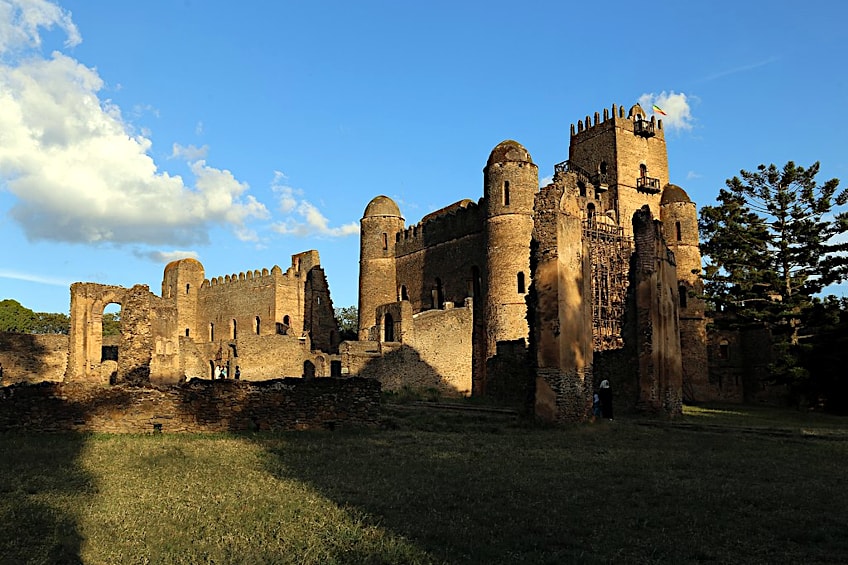
He would go on to furnish the castle with things like ivory sculptures and jewels embedded in the ceiling. However, the structure has taken on quite a bit of damage over the years thanks to natural disasters, military bombardments, and other external forces. The castle fell into quite a state of disrepair but eventually in 1979 it would be dubbed a UNESCO world heritage site and restored to its former glory.
Frederiksborg Castle (1620)
| Date Created | 1620 |
| Type of Architecture | Classic renaissance |
| Location | Hillerød, Denmark |
| Type of Castle | Renaissance castle |
While Denmark isn’t generally known for huge castles, if you’d like to see a classic example of renaissance architecture we highly recommend you check out the Frederiksborg Castle. This castle was built in 1620 by King Christian IV as a testament to his power in Norway and served as the royal family’s primary residence for over 100 years.
The famous fire of 1859 damaged early the entirety of the castle, but strangely the chapel located on the grounds was virtually unscathed.
To restore the rest of the structure a lottery was held as a fundraising effort so that the castle could be restored to its former glory. However, the Royal family decided not to stay in the castle, instead turning it into a museum that opened in 1878 to the general public. The castle and its interior are quite the sight, featuring many paintings, 60 rooms, four towers, and five floors for you to explore. The castle is an incredible place to learn about the history of Denmark and allows one to take in the natural beauty of the region as the castle is situated on the great Castle Lake.
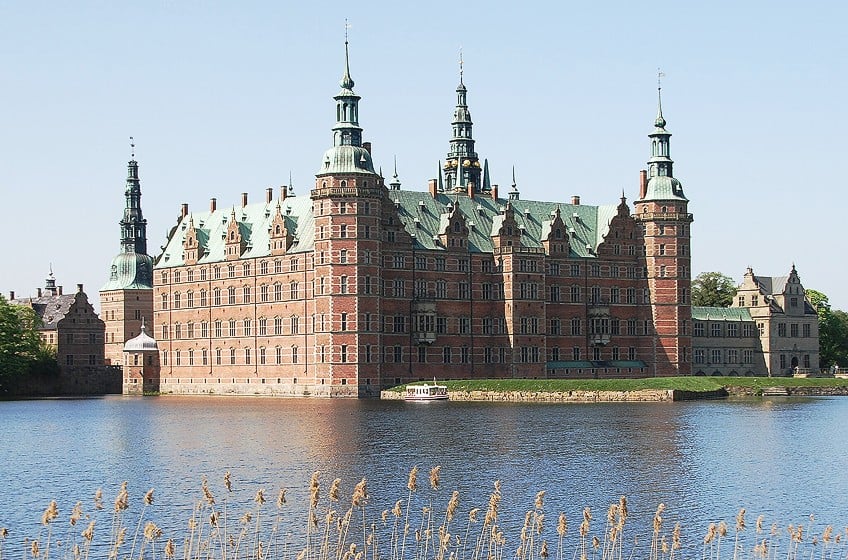
The Chapultepec Castle (1788)
| Date Created | 1788 |
| Type of Architecture | Neoclassical/Gothic |
| Location | Mexico City, Mexico |
| Type of Castle | Stone fort |
While you might think of a castle anywhere near North America as being out of place, this one seems to fit in quite nicely. Located in Mexico City, the Chapultepec castle is a huge facet of Mexican history that was commissioned for construction back in 1785 by Viceroy Bernardo de Gálvez to serve as the primary residence of the commander of the Spanish colony in the region. As you can imagine the Mexican people were fairly unhappy about being colonized by the Spanish, and after 1821 when Mexico achieved its independence the castle was repurposed to serve as a military academy.
The site would later go on to become the site of the battle of Chapultepec, one of many during the Mexican-American war of 1847.
The castle would undergo renovations once again thanks to Emperor Maximilian who modernized the floor plan of the structure, but he and his wife Empress Carlota would not get to enjoy their newly renovated abode for very long. Emperor Maximilian’s reign would come to an end when resident Benito Juárez once again took power in the region.
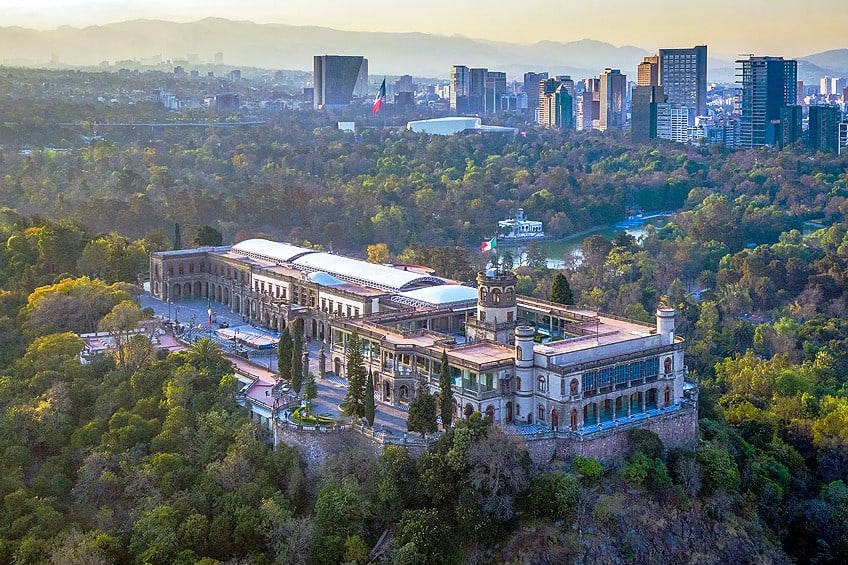
From the exterior, the castle does not have much in the way of elegant beauty. There are no sweeping vertical lines for the eyes to follow as with gothic architecture, but the imposing and rigid presence of this stone fort in addition to its windows and detailed railings make this castle a unique and powerful sight to behold.
The Nakhal Fort (1834)
| Date Created | 1834 |
| Type of Architecture | Oman architecture |
| Location | Nakhal, Oman |
| Type of Castle | Stone fort |
If you’re looking for a particularly interesting castle to visit we highly recommend that you check out the Nakhal Fort. The interesting thing about the Nakhal fort is that the shape of the structure is due to the fact that it’s been built around a rock that sits nearly at the center of the structure. The fort, therefore, has an off-center appearance.
What makes the Nakhal fort an interesting castle to visit is its unique architecture, shape, and history.
The purpose of the fort’s construction was to ensure that nearby trade routes and settlements could be adequately defended by those stationed at the fort. Over time, places of worship and markets would be included in the structure’s services.
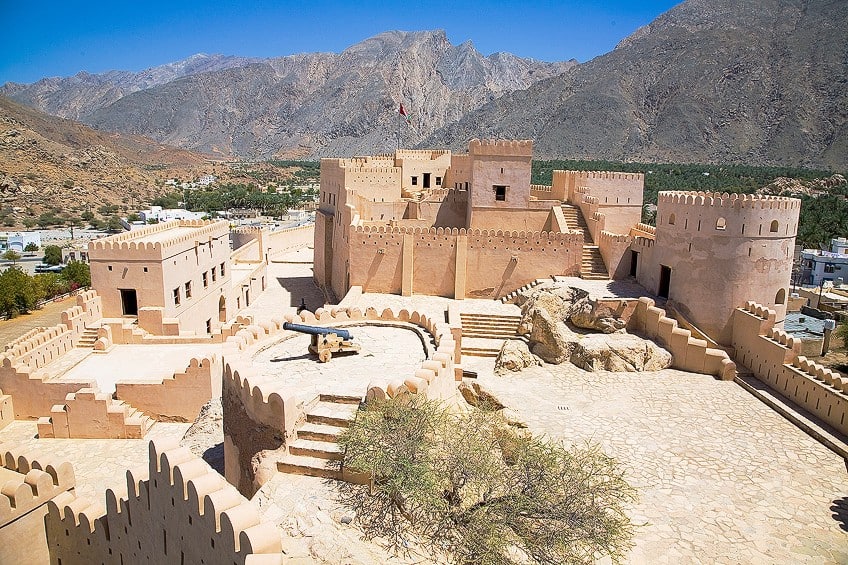
The fort notably has some hidden nooks that served as concealed locations for guards to throw date oil (extremely hot when cooked) on invaders. The fort is primarily a tourist destination in the region of Oman where you can learn about the history of the city, but there are also markets that take place on Wednesdays where you can interact with friendly goats and traders.
The Red Fort (1834)
| Date Created | 1834 |
| Type of Architecture | Style of the Sultanate of Oman |
| Location | Nakhal, Oman |
| Type of Castle | Stone fort |
One of the most famous castles in the world is the Red Fort located in Delhi, India. Indian forts and temples tend to be some of the most popular around the world, and the Red Fort illustrates why quite well. The temple was built in 1526 CE when Emperor Shah Jahan moved the capital of the region from Agra to Delhi, a then freshly constructed city.
The temple’s exterior is relatively bland compared to some of the other castles on this list.
This makes sense considering that it is made almost entirely of red stone, but it does compensate for this. The interior of the structure has been furnished with inlays and panel halls, as well as a mixture of various art forms from Hindu, Persian, and Timurid cultures. Aside from its diverse art and cultural influences, the temple also has an interesting history. It served as the seat of power for the Mughal Empire for years until the Indian Rebellion/uprising in 1857. As a result, a number of precious jewels were stolen from the fort as the ruler of the time, Shah II, was forcefully removed from power.
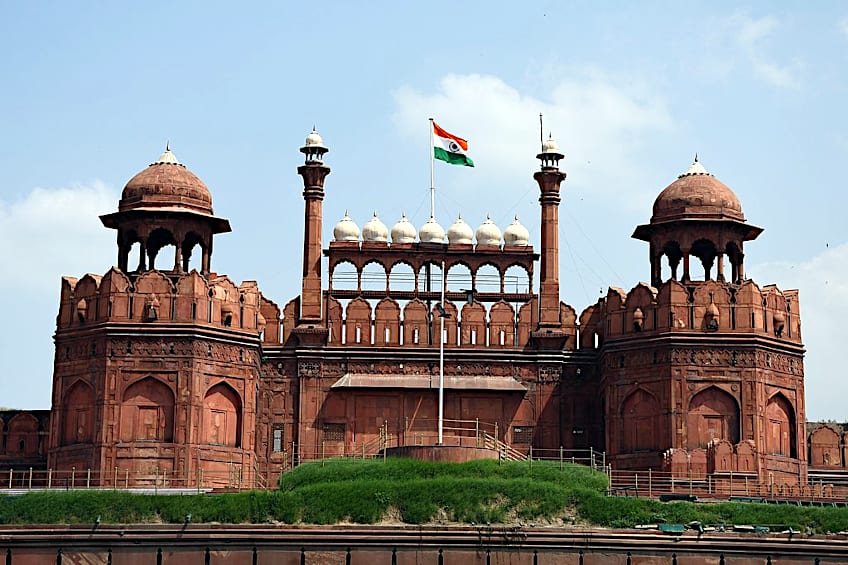
Additionally, the fort would serve as an important location during India’s fight to achieve independence from its British occupiers. In fact, it is the exact spot where the first prime minister of India, Jawaharlal Nehru, stood to deliver his Tryst with Destiny speech, and as a result, the prime minister of India will give a speech in this exact location annually.
The Pena National Palace (1854)
| Date Created | 1854 |
| Type of Architecture | Romanesque revival/Neo-Manueline |
| Location | Sintra, Portugal |
| Type of Castle | Romanticist castle |
Another castle with a unique aesthetic is the Pena National Palace in Portugal. The castle was built in 1854 by King Ferdinand II to serve as a summer home on the mountainside for the Royal family at the time. Like other castles in the region, this one is set on a picturesque mountainside of the Sintra Mountains.
The Pena Palace is considered by some to be the perfect illustration of eccentric and colorful Romanticism inside Portugal during the 19th century.
The design has heavy Baroque and Middle Eastern styling, which is evident by the use of colors and line work in the overall design and aesthetic of the structure. There are many eye-catching elements of the castle. Arguably the most prominent of which is the red clocktower that presides over the structure and the base below it. Other noticeable details are the yellow palace walls and the convent located on site. The castle was used quite frequently by the royal family right up until the revolution broke out in the region.
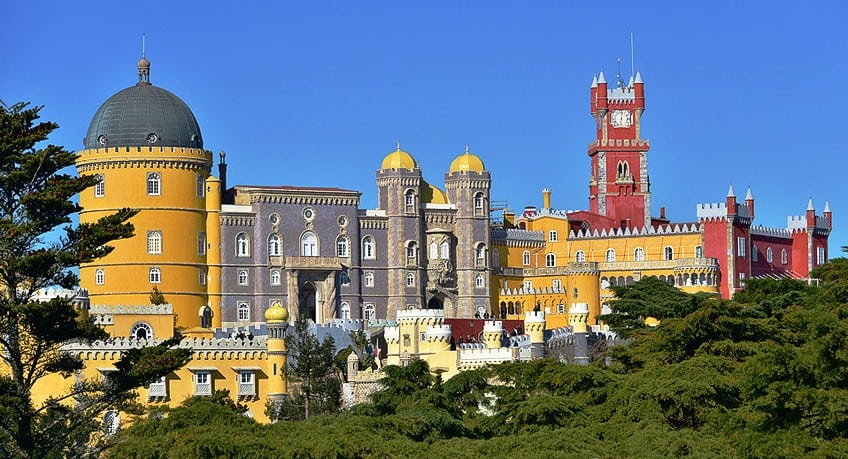
Due to being abandoned by the state for many years the castle would eventually be restored and dubbed a world heritage site by UNESCO. While there is no longer a royal family living in the castle, you can still see the castle for yourself as it has become quite a tourist destination thanks to its location and stunning interior.
The Neuschwanstein Castle (1868)
| Date Created | 1868 |
| Type of Architecture | Romanesque revival/Historicism |
| Location | Schwangau, Germany |
| Type of Castle | Stone fort |
While some castles are built as a weekend getaway and permanent residences, this castle was built as a refuge for the King of Bavaria at the time King Ludwig II. The castle was built in 1868 as a way for the king to get away from the political landscape in the country at the time, especially considering that he was effectively stripped of his power when Prussia took Austria.
It seems that the king sought to retain his noble status and still entertain guests of high status even though he was effectively no longer the ruler of the country.
There is a famous letter in which he notes that the castle will have several comfortable rooms, each with its own unique view of the countryside and nearby river. Even though much effort and consideration were put into the design and construction of the castle the king would never get to see or use the castle in its completed state. However, you can! The castle has been open to the public since the year 1886 and has become quite the attraction for people the world over.
Iconic Photochrom print of Neuschwanstein Castle taken in the first decade following the completion of the castle; See page for author, Public domain, via Wikimedia Commons
The Peleș Castle (1873)
| Date Created | 1873 |
| Type of Architecture | Renaissance revival/Gothic revival |
| Location | Sinaia, Romania |
| Type of Castle | Stone fort |
If you’re in the mood for a uniquely European vacation, we highly recommend you visit Romania, and while you’re there, treat yourself to visiting the Peles castle in Sinaia. This castle resembles a rather large country estate more than the classic imagery of a castle, but the overall aesthetic suits both the landscape and the indigenous architecture of the region well.
The castle was commissioned for construction by King Carol I when he viewed the Bucegi Mountain range for the first time, immortalizing both the castle and the scenery in the minds of the Romanian people forever.
The castle was built in the neo-renaissance style around 1860, just outside of the Village of Sinaia. The castle’s interior is sprawling with halls and around 160 rooms. What makes these rooms unique is that each of them has a dedicated theme to them, breaking away from the bland interior styling of conventional medieval castles. A good example of this is the theatre/viewing room that is covered in frescos by famous Austrian artists.
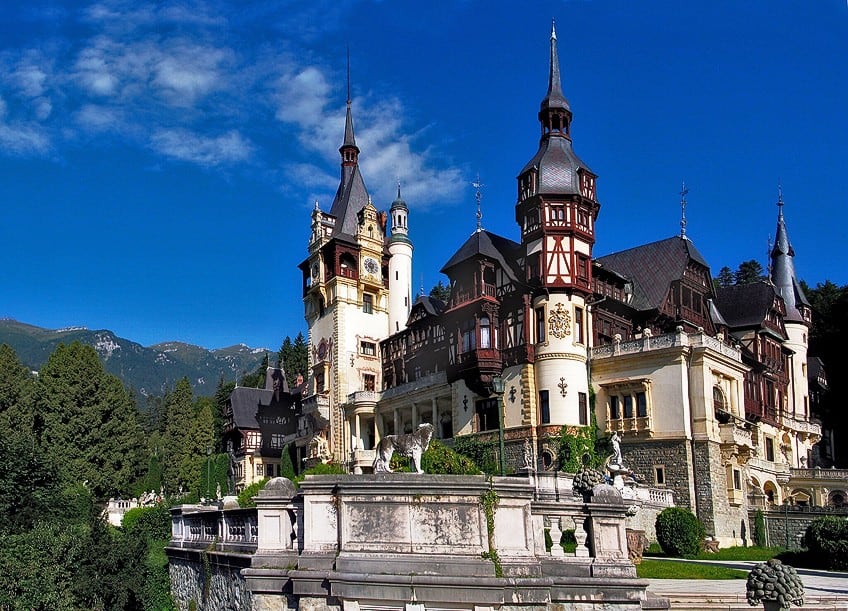
While you might be inclined to think that such a beautiful building has been snatched up by an eccentric billionaire years ago, it is actually a public museum! This is due to the castle being abandoned when Romania fell under communist rule in 1947, but thankfully it would be restored and opened to the public after nearly 40 years in 1989.
Now that you know what some of the most famous castles in the world are, where they can be found, why they were made when they were built, and what state they’re in today, it’s time for you to get out there and put your newfound knowledge to the test. If you have the opportunity to visit any of these beautiful sites, we highly recommend them!
Frequently Asked Questions
What Are Medieval Castles?
Put simply, what we call medieval castles are essentially any castles that were built between the beginning and end of the Middle Ages. These could be simple Motte and Bailey structures, or more intricate stone or concentric stone designs.
Why Do People Like Castles?
There are many reasons to like castles. Castles, and similar structures, are typically located in picturesque areas, are quite large and lavishly furnished, and tend to have interesting histories linked to their construction and/or inhabitants.
Do Castles Still Exist?
Castles still absolutely exist. While they might not be built in the same sizes and shapes that they were during the Middle Ages, the uber-wealthy still construct palaces all over the world. These typically have classic Medieval and Gothic stylings with modern amenities.
Justin van Huyssteen is a writer, academic, and educator from Cape Town, South Africa. He holds a master’s degree in Theory of Literature. His primary focus in this field is the analysis of artistic objects through a number of theoretical lenses. His predominant theoretical areas of interest include narratology and critical theory in general, with a particular focus on animal studies. Other than academia, he is a novelist, game reviewer, and freelance writer. Justin’s preferred architectural movements include the more modern and postmodern types of architecture, such as Bauhaus, Art Nouveau, Art Deco, Brutalist, and Futurist varieties like sustainable architecture. Justin is working for artfilemagazine as an author and content writer since 2022. He is responsible for all blog posts about architecture.
Learn more about Justin van Huyssteen and about us.
Cite this Article
Justin, van Huyssteen, “Famous Castles – 15 Legendary Fortresses Worldwide.” artfilemagazine – Your Online Art Source. October 13, 2023. URL: https://artfilemagazine.com/famous-castles/
van Huyssteen, J. (2023, 13 October). Famous Castles – 15 Legendary Fortresses Worldwide. artfilemagazine – Your Online Art Source. https://artfilemagazine.com/famous-castles/
van Huyssteen, Justin. “Famous Castles – 15 Legendary Fortresses Worldwide.” artfilemagazine – Your Online Art Source, October 13, 2023. https://artfilemagazine.com/famous-castles/.


